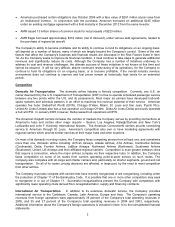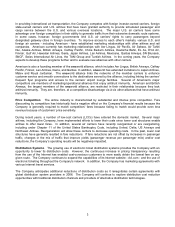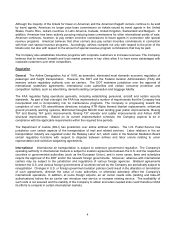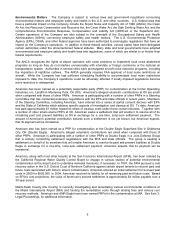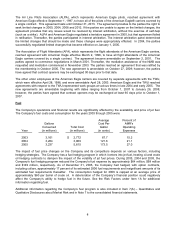American Airlines 2005 Annual Report Download - page 15
Download and view the complete annual report
Please find page 15 of the 2005 American Airlines annual report below. You can navigate through the pages in the report by either clicking on the pages listed below, or by using the keyword search tool below to find specific information within the annual report.12
Our indebtedness and other obligations are substantial and could adversely affect our business and
liquidity.
We have and will continue to have a significant amount of indebtedness and obligations to make future payments
on aircraft equipment and property leases. We may incur substantial additional debt, including secured debt, and
lease obligations in the future. We also have substantial, and increasing, pension funding obligations. Our
substantial indebtedness and other obligations could have important consequences. For example, they could:
• limit our ability to obtain additional financing for working capital, capital expenditures, acquisitions and
general corporate purposes, or adversely affect the terms on which such financing could be obtained;
• require us to dedicate a substantial portion of our cash flow from operations to payments on our
indebtedness and other obligations, thereby reducing the funds available for other purposes;
• make us more vulnerable to economic downturns;
• limit our ability to withstand competitive pressures and reduce our flexibility in responding to changing
business and economic conditions; or
• limit our flexibility in planning for, or reacting to, changes in our business and the industry in which we
operate.
We may be unable to comply with our financial covenants.
American has a fully drawn $788 million Credit Facility, which consists of a $540 million Revolving Facility with a
final maturity on June 17, 2009 and a $248 million Term Loan Facility with a final maturity on December 17, 2010.
The Credit Facility contains a liquidity covenant and a ratio of cash flow to fixed charges covenant. We were in
compliance with these covenants as of December 31, 2005 and expect to be able to continue to comply with
these covenants for the period ending March 31, 2006. However, given the historically high price of fuel and the
volatility of fuel prices and revenues, it is difficult to assess whether we will, in fact, be able to continue to comply
with these covenants, and there are no assurances that we will be able to comply with these covenants. Failure
to comply with these covenants would result in a default under the Credit Facility which - - if we did not take steps
to obtain a waiver of, or otherwise mitigate, the default - - could result in a default under a significant amount of
our other debt and lease obligations, and otherwise adversely affect our business.
We are being adversely affected by increases in fuel prices, and we would be adversely affected by
disruptions in the supply of fuel.
Our results are very significantly affected by the price and availability of jet fuel. Fuel prices increased significantly
in 2005 and remain high.
Due to the competitive nature of the airline industry, we may not be able to pass on increased fuel prices to
customers by increasing fares. In fact, recent history would indicate that we have limited ability to pass along the
increased costs of fuel. If fuel prices decline in the future, increased fare competition and lower revenues may
offset any potential benefit of lower fuel prices.
While we do not currently anticipate a significant reduction in fuel availability, dependency on foreign imports of
crude oil, limited refining capacity and the possibility of changes in government policy on jet fuel production,
transportation and marketing make it impossible to predict the future availability of jet fuel. If there is an outbreak
of hostilities or other conflicts in oil producing areas or elsewhere or a reduction in refining capacity (due to
weather events, for example), there could be reductions in the supply of jet fuel and significant increases in the
cost of jet fuel. Major reductions in the availability of jet fuel or significant increases in its cost, or a continuation of
current high prices for a significant period of time, would adversely affect our business.
While we seek to manage the price risk of fuel costs by using derivative contracts, there can be no assurance
that, at any given time, we will have derivatives in place to provide any particular level of protection against
increased fuel costs. In addition, a deterioration of our financial position could negatively affect our ability to enter
into derivative contracts in the future.


